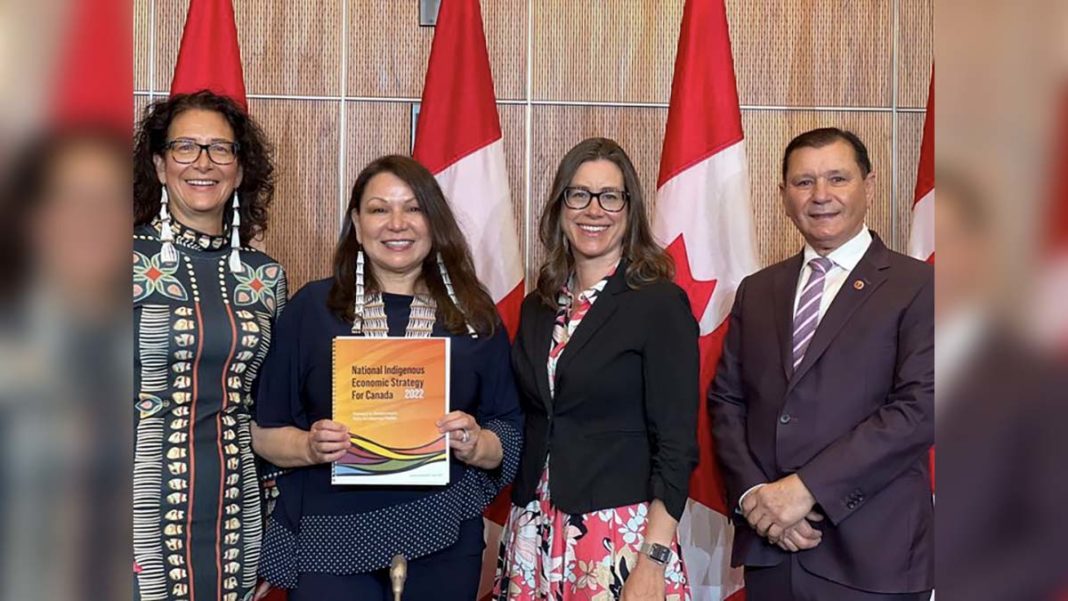OTTAWA—Almost since the first days of contact with European settlers, the economic fate of Indigenous peoples has been steered by outsiders, with various governmental agencies and commissions creating reports ostensibly aimed at alleviating the endemic economic malaise that has afflicted First Nations communities with a “we know what’s good for you” vibe running throughout their pages. Most of the recommendations in those reports remain collecting dust on various department shelves.
Spearheaded by a group of five national Indigenous economic development agencies and informed by 25 national Indigenous organizations, it was determined that the time was overdue for a study aimed at producing a blueprint for Indigenous economic development produced through an Indigenous lens. The report, unveiled on Monday, June 6 at the National Press Gallery room in Ottawa, was structured along the lines of the Truth and Reconciliation Committee Report and contains 107 “calls to action.”
Dawn Madahbee Leach, general manager of Waubetek Business Development Corporation and chair of the National Indigenous Economic Development Board (NIEDB) was one of the leads on the group that helped to draft the report.
Ms. Madahbee Leach spoke to The Expositor about her reaction to the event. “We had such a great day,” she said. Ms. Madahbee Leach was quick to point out that she was just one of many of those who collaborated on the report. “We had found that previous reports didn’t represent our voices,” she said. So, in 2020, the steering group began working on an Indigenous-created report.
The importance of the issue cannot be overstated, she notes, as improved economic outcomes for Indigenous communities has a knock-on effect on the economies of surrounding non-Native communities—rising tides raise all boats, to the tune of an estimated $30 billion potential for the Canadian GDP.
As a frontline organization on the Indigenous economic development front, Waubetek sees first-hand the challenges facing Indigenous entrepreneurs in taking their visions to fruition. Indigenous businesses have faced historical challenges, given the reluctance of banks to finance projects where there are challenges in securing equity. Lingering systemic racism and a stereotype that Indigenous borrowers would not pay off their loans added to the mix.
“We need to change the page on Indigenous people being the highest-risk capital and see that their participation in resource projects actually de-risks the project,” said Shannin Metatawabin, CEO of the National Aboriginal Capital Corporations Association and one of the authors of the report.
Ms. Madahbee Leach pointed out that Waubetek’s experiences in providing loans to Indigenous business has given the lie to those perceptions, boasting a completion rate that would put just about any lending institution to shame.
But Waubetek is limited in its ability to fund projects. As a federally funded Aboriginal Financial Institution (AFI), they face a $400,000 loan ceiling which falls far short of what a construction company would need to finance a new excavator or to backstop an entrepreneur who wants to open a franchise restaurant on reserve.
“We feel like our hands are tied,” Ms. Madahbee Leach said. “I’d love to do the loans because these are clients of ours who have already proven themselves, but we don’t have that level of financing available.”
AFIs have provided some $2.4 billion in loans to Indigenous businesses over the past 25 years, leveraging $365 million in government funding, but this falls far short of what is needed to end poverty and a lack of opportunity in First Nation communities. That shortfall costs an estimated $27.7 billion each year, according to a 2016 report from the National Indigenous Economic Development Board cited in the Indigenous Economic Development Strategies.
Over the course of three meetings, with a first draft in 2019, a second in 2020 and a third in 2021, the vast on-the-ground expertise of the five contributing organizations was incorporated into the 107 recommendations contained in the strategy.
The strategy has four strategic pathways, explained Ms. Madahbee Leach: people, lands, infrastructure and finance. Contained within the report are 107 Calls to Economic Prosperity aimed at guiding Canadian society toward a more equitable and prosperous future.
Ms. Madahbee Leach noted that the release of the report was attended not only by members of the press, but also by representatives from major corporations and several cabinet ministers and bureaucrats, but unlike many previous reports on Indigenous economic development strategies, the people standing at the front of the room were not government representatives or bureaucrats, but Indigenous business leaders.
The strategy recommends strengthening funding for AFIs to meet loan demand. It also calls for major infrastructure overhauls, noting the current regime ensures infrastructure in Indigenous communities “costs the most to build, takes the longest to develop, and has the shortest operational life” when held up to other
government projects.
That infrastructure includes drinking water systems, as the report notes. In 2021, a report by the Auditor General of Canada found the federal government’s efforts to address long-term drinking water advisories on reserves were hamstrung due to outdated policies and funding formulas.





